
- Index
- Amperage
- Brand
- Item Height
- Item Type
- Item Width
- Power Source
- 2-d-cell Batteries (2)
- Battery (254)
- Battery, Gas (4)
- Battery, Propane Gas (22)
- Coal (4)
- Corded Electric (255)
- Electric (124)
- Electric, Gas (2)
- Gas (103)
- Gas / Petrol (7)
- Liquid Propane (8)
- Lpg (3)
- Natural Gas (2)
- Network Operation (10)
- Ng (natural Gas) (25)
- Propane (2)
- Propane Gas (465)
- Propane Liquid (4)
- corded Electric (3)
- Other (1074)
Eccotemp 20HI Indoor 6.0 GPM Natural Gas Tankless Water Heater US Seller
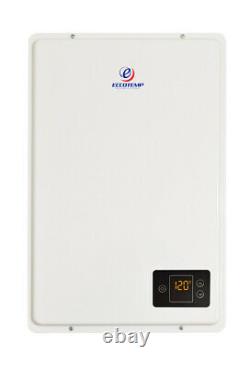
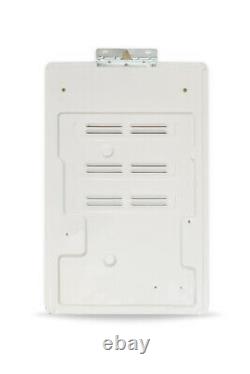
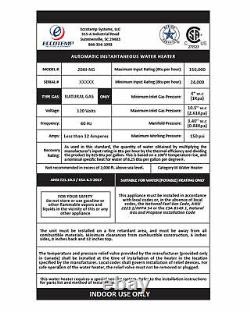
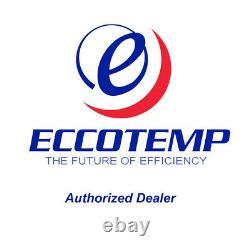
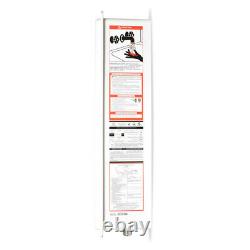
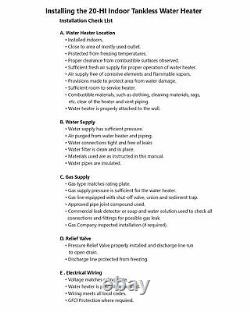
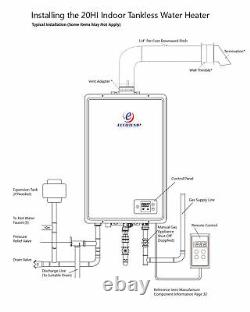
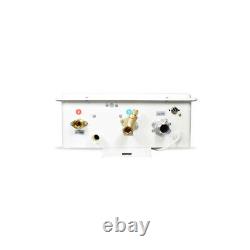
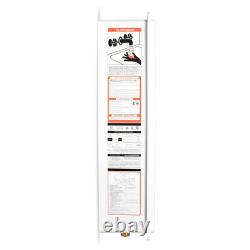
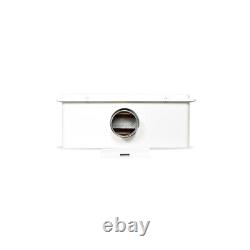
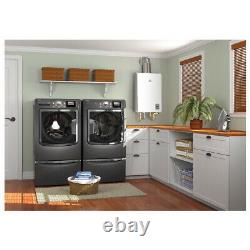


Never be without hot water. Tired of waiting for your water to reheat? Eccotemp Tankless Water Heaters provide an endless supply of hot water for all your needs. The Eccotemp 20HI Indoor 6.0 GPM Natural Gas Tankless Water Heater is the Newest indoor model of the Eccotemp tankless line.
The compact, wall mounted Eccotemp 20HI-NG is powered by natural gas. Rated at an impressive 6.0 gallons per minute (GPM) and 150,000 BTU per hour, the Eccotemp 20HI-NG can meet all the hot-water needs of a standard home or apartment with one or two bathrooms, as well as smaller commercial applications. The Eccotemp 20HI-NG is ready to install with its 110/120-volt UL listed power cord powering the internal exhaust fan and digital display. With its fully automated control system, the Eccotemp 20HI-NG only pulls about 12 amps during operation, making it an ideal choice for any standard-sized home. CSA Certified for US and Canadian Use.
Activation Flow: 0.7 GPM. Hot Water Capacity Range: 0.7 - 6.0 GPM. 38-Degree Fahrenheit Temperature Rise: 6.0 GPM. Maximum Gas Rate: 150,000 BTUs. Minimum Gas Rate: 24,000 BTUs.
20HI Indoor Natural Gas Tankless Water Heater. 110/120-Volt UL Listed Power Cord. Map Zone: Northern Region, Mid Region, Southern Region. Flow: Rate 6.0 GPM. Applications: Standard Home, Cabins, Apartment/Townhome. Power Type: Natural Gas (NG). Unit Dimensions:16.60" x 28.00" x 9.40. Installation distances may vary by local code. It is the installers responsibility to verify installation requirements. Water Heater cannot be installed in an UN-VENTED bathroom, bedroom, basement, living room, closet, outdoor, stairway or an exit area. If installed in an exit area, it must be at least 16.5 ft. Or more away from the exit. High Altitude The Eccotemp 20HI has been tested for use at elevations up to 2000 feet. Installation and use of the Eccotemp 20HI above 2000 feet may effect overall product efficiency and performance. Installation and use of the Eccotemp 20HI above 5000 feet is not recommended.IMPORTANT NOTE : Cannot be used for HYDRONIC SYSTEMS, RECIRCULATING, or FLOOR HEATING. We recommend using our Eccotemp EZ-Flush System Descaler Kit to ensure a clean, energy efficient, long lasting heater! We take our business very serious and appreciate your business. We strive to provide you with excellent customer service and post sales assistance. How Tankless Water Heaters Work.
Selecting the Right Size Unit. Eccotemp was founded in 2004 and are family owned and operated. Since their conception they have utilized the latest technological advances to engineer products that operate with maximum efficiency and conserve energy. Their mission is to improve the lives of their customers and to spread awareness about the benefits of ecologically-friendly products. Eccotemp is constantly researching and developing improvements for the full spectrum of products and services they provide. They believe that everything they do should positively impact the lives of their customers. Learn about Eccotemp Tankless Water Heaters.Eccotemp tankless water heaters, also called instantaneous, continuous flow, inline, flash, on-demand or instant-on water heaters, are also available and gaining in popularity. These water heaters instantly heat water as it flows through the device, and do not retain any water internally except for what is in the heat exchanger coil. Tankless heaters are often installed throughout a household at more than one point-of-use (POU), far from the central water heater, or larger models may still be used to provide all the hot water requirements for an entire house.
The main advantages of Eccotemp tankless water heaters are a continuous flow of hot water and energy savings (as compared to a limited flow of continuously heating hot water from conventional tank water heaters). How Eccotemp tankless water heaters work. When there is a demand for hot water e. A hot water tap is opened for a sink, shower, tub, or washing machine the tankless water heater's water flow turbine senses the flow and starts the heating process.
The water flow turbine sends a signal to the control board which looks at multiple factors: incoming water temperature, desired water temperature as set on the temperature controller, and the calculated difference between the two temperatures. Depending on the calculated incoming and desired water temperatures, the gas or electric flow into the burner assembly is modulated and the electronic ignition sequence begins. Water is heated to the desired temperature as it circulates through the copper heat exchanger providing continuous hot water. When the hot water tap is turned off, the tankless water heater shuts down and is placed in a standby mode pending the next call for hot water. Advantages to Owning an Eccotemp Tankless Water Heater.
There are certain advantages to Eccotemp tankless water heaters. Long term energy savings: Although a tankless water heater might cost more initially it may result in both energy and cost savings in the long term. As water is heated only when it is needed, there is no storage of hot water. With a tank, water is kept warm all day even if it never gets used and heat loss through the tank walls will result in a continual energy drain. Even in homes or buildings with a high demand for hot water, a tankless water heater may provide some level of savings.
In a typical home these savings are quite substantial. If instant hot water at the taps at limited hours is a priority, a recirculation system similar to those in the tank-type systems can be accommodated by using an aquastat and timer in order to decrease the added heat loss from the recirculation system.
It has to be said though that if the storage tank is highly-insulated a few tanks are available with excellent levels such as 100 mm or more polyurethane foam the savings become minimal. For one consumer-grade electric storage water heater, the surface temperature was less than 1 °C higher than the air temperature. Unlimited hot water : As water is heated while passing through the system an unlimited supply of hot water is available with a tankless water heater.
Although flow rate will determine the amount of hot water that can be generated at one time it can be generated indefinitely. However, this can also be a disadvantage as running out of hot water self-limits use while a tankless heater has no such limit. Less physical space: Most Eccotemp tankless water heaters can be mounted on a wall or even internally in a building's structure. This means less physical space has to be dedicated to heating water. Even systems that can't be mounted on walls take up less space than a tank-type water heater.
Reduced risk of water damage: No stored water means there is no risk of water damage from a tank failure or rupture, although the risk of water damage from a pipe or fitting failure remains. Improper piping in either the hot or cold water lines to the tankless water heater can result in water damage though. Temperature compensation: A temperature compensating valve tends to eliminate the issue where the temperature and pressure from tankless heaters decrease during continuous use.
Most new generation Eccotemp tankless water heaters stabilize water pressure and temperature by a bypass valve and a mixing valve which is incorporated in the unit. Modern Tankless are not inversely proportional, because they will regulate the amount of water that is created and discharged, therefore stabilizing water temperature by utilizing a flow control valve. Flow speed is not the issue, but change in temperature is the important issue to address. The wider the temperature rise, the less flow you receive from the unit.
The smaller the temperature rise, the more flow you receive. The flow control valve in conjunction with thermistors, maintains a stable temperature throughout the use of the unit. Safety: Eccotemp tankless water heaters can precisely control the temperature of the treated water, which means dangerous temperature levels and spikes are no longer a problem.
Credit: Eccotemp Article # 115011374028. How to Select the Right Size Tankless Water Heater. Tankless water heaters are rated by the maximum temperature rise possible at a given flow rate. Therefore, to size a demand water heater, you need to determine the flow rate and the temperature rise youll need for its application (whole house or a remote application, such as just a bathroom) in your home.
Determine the maximum number of devices you want to run and their total flow rate. Then, add up their flow rates (gallons per minute). This is the desired flow rate youll want for the demand water heater. For example, lets say you expect to simultaneously run a hot water faucet with a flow rate of 0.75 gallons per minute and a shower head with a flow rate of 2.6 gallons per minute.
The flow rate through the demand water heater would need to be at least 3.26 gallons per minute. To reduce flow rates, install low-flow water fixtures. To determine temperature rise, subtract the incoming water temperature from the desired output temperature.
Unless you know otherwise, assume that the incoming water temperature is 50°F By using a low temperature assumption you ensure that you will not under size your tankless unit. If you live in a warm climate your water temperature will likely be much higher. For most uses, youll want your water heated to around 105115°. In this example, youd need a demand water heater that produces a temperature rise of 55°. Sizing Example: An average shower will be between 104106° and uses 2.6 gallons of water.Assuming your water temperature is 40° coming into your home, and you want to produce enough hot water to run 2 showers at the same time, what temperature rise would you need to produce to accomplish this? Answer: Youll need to raise the incoming water temperature from 40 degrees to 105.
Youll need to be able to heat at least 5.2 gallons of water. So youll need a tankless water heater that can produce at least a 60 degree rise in temperature at 5.2 gallons per minute. How much hot water do you need at one time? Do you need to run 2 showers at the same time or maybe a shower and a couple sinks? The chart below shows the range of water usage range and average water temperatures for various fixtures. We suggest using 2.5 gpm for a shower and 1.0 gpm for a bathroom as a reference point in determining your total simultaneous water needs. 2.5 3.0 GPM. For example, if you are running 2 showers at the same time, you will need 5 gallons of hot water per minute from the tankless water heater. If you were running a shower and the washing machine at the same time, you would need 4.5 gallons per minute from the water heater. In either of these situations, you will want to size the unit that meets or exceeds how much hot water you need at the same time.Tankless water heaters are intended to heat potable (drinking) water only and the inlet water to a tankless unit should not be pre-heated. Gas tankless water heaters are able to produce a larger temperature rise per gpm than electric models.
Most demand water heaters are rated for a variety of inlet temperatures. Typically, a 70°F water temperature rise is possible at a flow rate of 5 gallons per minute through gas-fired demand water heaters and 2 gallons per minute through electric water heaters.
Faster flow rates or cooler inlet temperatures can sometimes reduce the water temperature at the most distant faucet. Eccotemp makes no other claims, expressed or implied herein.Outdoor model numbers 45H-NG, 45H-LP, EL22-NG, EL22-LP and indoor model numbers 45HI-NG, 45HI-LP, EL22I-NG, EL22I-LP have an antifreeze protection circuit installed on the units. This circuit will protect the units down to -30 degrees F from freezing. NOTE : THIS DOES NOT COVER FREEZING FROM FROZEN WATER IN THE PIPES. FROZEN WATER IN THE INCOMING OR OUTGOING WATER LINES MAY CAUSE A RUPTURE IN THE HEAT EXCHANGER AND PIPES.
ECCOTEMP SYSTEMS, LLC ALSO RECOMMENDS THE APPROVED VENT KITS FOR 45HI-NG, 45HI-LP, EL22I-NG, EL22I-LP INDOOR MODELS. USING A VENT KIT WITHOUT A BACKFLOW PREVENTER MAY CAUSE DAMAGE. In order to prevent this, you must take the following steps.Ensure that the unit is plugged in and there is electricity being supplied at that outlet. YOU MUST ENSURE THAT THE PIPES ARE INSULATED WITH HEAT TAPE or YOU MUST KEEP THE WATER ON AT A TRICKLE TO ENSURE NO FREEZING INCURS.
Your vent kit must have a back-flow preventer to ensure cold air does not backflow through to the heat exchanger and risk freeze damage. It is the homeowner and/or installers responsibility to ensure that the incoming and outgoing water lines are properly insulated and protected against freeze.
Outdoor model numbers L5 , L7 & L10 along with the indoor models numbers FVI12 , i12 and iE series DO NOT have an antifreeze circuit installed. If the temperatures get at or below freezing or if these conditions are anticipated, you MUST drain the unit by unscrewing the drain stem located at the bottom right of the unit as well as unhook the incoming and outgoing water line to ensure proper drainage from the heat exchanger. L5 , L7 & L10 should be taken down and stored away in a warm safe place. For more information on how to better prepare your water heater for the winter, download the PDF Winterizing Your Unit. Credit to Eccotemp Articles # 115011222507. Winterizing your Tankless Water Heater. Is your Eccotemp tankless water heater ready? We are here to help!How to winterize a Tankless Water Heater. If you have a tankless water heater that is not used for a longer period of time, and the place where you live is subjected to the freezing temperatures, it is very important to protect the unit during this cold winter time. Use the step-by-step guide below to learn how to winterize tankless water heater and avoid failure of the unit.
Many new tankless water heaters with the advanced technology and features like protection against freezing cold can be found today from the main manufacturers, like Rheem, AO Smith, Rinnai, Paloma... And during the winter time they can protect the system from freezing down to -30 F or even lower.But, don't rely on such a great feature. These units are using an electric power as a protection system, so if there is a power outage, guess what... Your tankless unit will fail.
This is why you should learn how to winterize tankless water heater during the cold days. Adding the anti-freeze solution is also not recommended as it can cause the damage to the heater's components. This is especially important if the tankless water heater is installed in places like cabins, garages, and if you are absent for a long time. One of the main steps in how to winterize the unattended tankless heater is to drain and unplug the unit. If there is no water in the heater's pipes and especially in the heat exchanger, the unit will not be damaged due to the freezing conditions. So, how to prepare the heater for winter? First you have to turn the electrical power and gas supply off. Turn the gas off by using the main valve on the gas supply line, and for the electricity unplug the power supply cord. If the unit has the display at the front of the unit, it should be black. If your tankless heater was working, you still have some hot water inside the unit.Wait for a while until it cools down. Shut off the water supply on the main shut-off valve. Open the taps so the system can drain and release the pressure from the plumbing system. Disconnect incoming and outgoing water pipes from the tankless heater. Remove the inlet water filter.
Use the bucket to collect the residual water. Make sure that it fully drains from the system. Now the water heater doesn't contain any water and it is fully winterized.
Some manufacturers recommend using the air compressor, blow short bursts of air through the inlet connection to make sure there is no water left inside the heater. Credit to: Hot water heaters reviews. Which Unit Should I Use For My Radiant/Floor Heating Needs? Did You Know Electric Tankless Water Heaters Are Great For Radiant/Floor Heating? Radiant in-floor heating is a comfortable way to experience heat evenly throughout a home.Interestingly, with radiant surfaces everywhere, air temperature in a house can actually be lower than what you think is comfortable, and you will still feel warm. A well-designed hydronic heating system can be very economical in terms of energy use. This is especially true when a high-efficiency tankless water heater is used as the main hot water source. For even greater savings, it's possible to install a solar thermal system that will allow the sun to do some of the water-heating work. The system with a tankless water heater will also be much more responsive, have unlimited supply of hot water and clean water running through the floor heating pipes without sediments and other mineral build-ups.
A tankless hot water heater is ideal for this application since there is no water to be kept hot at all times. The water is heated only when needed or requested.
Water is fed through a super efficient heat exchanger and then heated. The water temperature is heated to the selected temperature setting precisely by adjusting the gas burner's flame to the desired temperature. Water temperature sensors monitor the water temperature and the tankless water heater's computer modulates the burner. This means that the water is never over heated or under heated. Regardless of the heat dissipating rate of the pipes the water is heated to the set temperature instantly due to the ability of the tankless water heater to vary its heating flame and power. The result is a very responsive system that can quickly replenish the lost heat in the pipes and therefore quickly heat the floor in case of floor heating application. This heating system uses the entire finished floor as a giant radiator. Hot water is pumped through plastic tubing installed beneath the finished floor surface. A hydronic radiant floor can be installed beneath tile or wood; it can also be embedded in a poured concrete slab. It's not a wise choice beneath wall-to-wall carpet because the carpet doesn't conduct heat very well. The traditional tank boiler is not able to do this because it cannot vary its flame intensity. A properly designed and installed system provides then comfortable and efficient floor heating regulated by a standard thermostat inside the home. Other than providing fast heating response the hydronic system enables large continued energy savings for years lowering significantly the operating cost of floor heating. We recommend taking a look at our iE Series. Along with the iEs sleek and modern design, this energy efficient model consists of multiple heating elements to share the workload and extend the life of the heater also ensuring that you enjoy a steady stream of endless hot water for years to come. The iE series electric tankless water heaters are 96% efficient, saves water and can use up to 60% less electricity than conventional tank water heater, making it cost-effective and environmentally friendly. Credit Eccotemp Article # 360001005688. According to ANSI code, gas tankless water heaters normally require stainless steel, category II/III vent pipe.As such, the gas is extremely hot when it leaves the water heater, but cools quickly. This cooling process results in acidic condensation which could eat through regular galvanized pipe. EccoTemp Systems recommend using Z-Flex vent pipe. Both of the i12 and FVI12 models use 2.5" single walled venting while the 45 Series uses 4" single walled venting. We always recommend a horizontal installation when it is possible.
It requires less pipe and as such, less expensive. When doing a horizontal run, your maximum lengths are as follows. Each elbow is equivalent to 5' of straight pipe. When installing a vertical vent stack, you will need the following pieces.
NOTE: A TERMINATION HOOD OR STRAIGHT PIPE SECTION MUST BE EQUIPPED WITH A DAMPER/BACKFLOW PREVENTER IS MANDATORY TO ENSURE THAT FREEZING AIR DOES NOT COME BACK DOWN THROUGH THE VENT STACK. Find out more about Freeze Damage by "Freeze and Gas Warning" and the "Winterize the Unit" tabs in this listing. Credit: Eccotemp Articles # 115011224407. Determining The Required Meter and Regulator size. Find the BTU requirement of each appliance in the home.
In our example above, we have the following: 199,900 BTU Tankless, a 75,000 BTU Furnace, a 55,000 BTU Range, a 25,000 BTU Dryer, and a 40,000 BTU Gas Log Fireplace. The sum of these appliances is 394,900 BTU.
Since most gas regulators and meters are rated in Cubic Feet per Hour, we need to convert the BTU calculation to ensure they are sized correctly. Divide total BTU by 1,024 to get the estimated Cubic Feet per Hour (CFH) requirement for the meter and regulator; 386 CFH in our example.If the water heater was a typical tank type at 40,000 BTU, then the overall system requirement would have been just 235,000 BTU with a meter and regulator rated at 235 Cubic Feet per Hour. A typical household meter and regulator is commonly rated at 250 Cubic Feet per Hour. As you can see that in the example above, when you change the water heater to a tankless, the existing regulator and meter would be potentially undersized. It is important to have a properly sized meter and regulator on the system; otherwise, the appliances on the system could experience operational issues. The local gas utility can provide more information on upgrading the meter and regulator for the home.
Hybrid pressure systems, with a 2 psi static pressure with regulators at each appliance, are sized differently than in this example. Consult your local gas supplier or the National Fuel Gas Code in regards to these type systems. There are two basic pipe sizing methods: longest length and branch length. Proper sizing will allow the system to maintain the required minimum pressure drop. Branch length sizing is the most common method. Determining Pipe Size by Length and Capacity. We will need to calculate the total load of the system and each branch.In our sample system, Figure 1, measure and add the lengths of pipes at each section. Total the BTU of the appliances for each branch line and the main trunk line back to the gas meter. Select the appropriate sized gas line based on length, BTU capacity, and pressure drop from Table 2, Table 3, or Table 4. You can see that, in a typical gas system, a tankless water heater with a capacity of 199,900 BTU will require a 1-inch pipe size for a 20 ft branch length based on the 0.3 in w. Pressure drop in Table 2.
The same appliance would require just a ½ pipe size based on Table 4 the 3.0 in w. A branch line is a pipe off the main line that feeds a group of appliances. In our example, we have two branch lines. The pipe size of the main pipe on the branch must be sized based on the total BTU of all the appliances on that branch line and pipe length. The trunk line pipe is the main pipe from the meter/regulator that feeds the different branches. The trunk line must be sized based on the total BTU from each branch-line system or the sum of the total BTU of all the appliances on the system and pipe length. Items such as elbows, tees, and valves are not included in these sample calculations. Their equivalent pipe length should be included when sizing gas systems. It is recommend that a licensed gas tradesman size, design, and install the gas system.Pipe Sizing Formula and Factors. You can calculate the required inside diameter of the piping required for a specific appliance/system capacity and length.
Calculate Q by dividing the BTU capacity of the appliance(s) by 1,024. To determine the allowable pressure drop, find the system static input gas pressure using a Manometer. Subtract the highest minimum gas pressure from the static input gas pressure to get the difference. For example, the input static pressure is 7 in.The highest minimum pressure is 6 in. Leaving a difference of 1 in. In this example the system can have a. Pressure drop based on Table 3. If the input pressure was 9 in.
In this example, then a 3.0 in. Pressure drop based on Table 4 would be allowable. The information in this article is meant for educational purpose only; it is not meant to be an engineering guide or supplement any national or local code. All national and local codes must be followed.Refer to the National Fuel Gas Code or your local gas supplier or code official for information. Gas systems should be designed, installed, and inspected by a certified and licensed gas fitter, engineer, or tradesman. The Eccotemp L5 and Eccotemp L10 model heaters have a 1/2" to 3/8" adapter in the hardware pack for attachment of the LP hose to the heater. This adapter must be installed with thread sealant , a spool of pipe tape which is included with the tankless water heater is recommended for use.
Multiple wraps of pipe tape may be necessary to assure complete seal. Always check for gas leaks before using the heater. Before attempting to light the water heater make sure to look and smell for gas leaks.
Use a soapy solution to check all gas fittings and connections. Bubbling at a connection indicates a leak that must be corrected. When smelling to detect a gas leak, be sure to sniff near the floor also.
Weekends and holidays are excluded. Concealed damages must be reported to the carrier within 24 hours of receipt. If there is obvious visible damage to the package, please document with photos or video if possible. These will be requested to help settle any claim with the carrier. Keep the product until we notify you with instructions. If you return an damaged order directly to us, you may jeopardize our ability to settle claims with the carrier. Return items must be in the. Original unused and or uninstalled condition. Below you will find product's return specifics. Feedback is very important to us. We encourage our customers can leave their Feedback for us.We also encourage those with questions to ask away. It is a fact that anyone who is provided with enough information is capable of making an intelligent informed decision. And, That's a good thing!
Who is BonRan Home Plus? We are an Authorized Dealer for many different quality products. Because we offer products that bring solutions, efficiency, comfort or pure enjoyment for a relaxing environment in the home or workplace. Our feedback reflects how we do business and treat our customers. Give us a chance to provide you with the product you desire because.. "We Want to do Business With You". We will be most willing to work with you to straighten any issues out. The item "Eccotemp 20HI Indoor 6.0 GPM Natural Gas Tankless Water Heater US Seller" is in sale since Wednesday, August 14, 2019. This item is in the category "Home & Garden\Home Improvement\Heating, Cooling & Air\Water Heaters\Tankless Water Heaters".The seller is "bonranacct" and is located in Summerville, South Carolina. This item can be shipped to United States, Canada, United Kingdom, Denmark, Romania, Slovakia, Bulgaria, Czech republic, Finland, Hungary, Latvia, Lithuania, Malta, Estonia, Australia, Greece, Portugal, Cyprus, Slovenia, Japan, China, Sweden, South Korea, Indonesia, Taiwan, South africa, Thailand, Belgium, France, Hong Kong, Ireland, Netherlands, Poland, Spain, Italy, Germany, Austria, Bahamas, Israel, Mexico, New Zealand, Singapore, Switzerland, Norway, Saudi arabia, Ukraine, United arab emirates, Qatar, Kuwait, Bahrain, Croatia, Brazil, Chile, Colombia, Costa rica, Panama, Trinidad and tobago, Guatemala, Honduras, Jamaica, Barbados, Bangladesh, Bermuda, Brunei darussalam, Bolivia, Ecuador, Egypt, French guiana, Guernsey, Gibraltar, Guadeloupe, Iceland, Jersey, Jordan, Cambodia, Cayman islands, Liechtenstein, Sri lanka, Luxembourg, Monaco, Macao, Martinique, Maldives, Nicaragua, Oman, Peru, Pakistan, Paraguay, Reunion, Viet nam, Uruguay.
- Features: Digital Display
- Manufacturer Warranty: 5 Years
- US SELLER: YES
- Warranty Heat Exchanger: Yes / 10 Year
- MPN: 20HING
- Protection Properties: Freeze Protection
- Minimum Flow Activation: Less Than 1 gpm
- Tank Warranty Lifetime: 5 Years
- Installation: Indoor
- Minimum Inlet Gas Pressure: 4 w.
c (1Kpa)
- Voltage: 110/120 V
- Water Heater Profile: Compact
- Item Height: 28 in
- Max Flow Rate: 6.0 GPM
- Power Source: Electric
- Country/Region of Manufacture: China
- Unit Dimensions: 16.60" x 28.00" x 9.40"
- UPC: 853868008264
- Water Connection: 3/4 in NPT
- GTIN: 00853868008264
- Mounting Location: Wall
- Model: 20HI-NG
- Energy Consumption: 150,000 BTU
- Suggested Locations: All Regions
- Heating System: Instantenous (Tankless)
- Water Connection Location: Bottom
- Tank Lining Material: Stainless Steel
- Manifold Pressure: 3.40'' w.c (0.84Kpa)
- Warranty Parts: Yes / 5 Year
- Application: Whole House
- Authorized Dealer: Yes
- Maximum Inlet Gas Pressure: 10.5'' w.c (2.61Kpa)
- Power: Less than 100 W
- CSA Certified: Yes, US and Canada
- Brand: Eccotemp
- Color: White
- Energy Star: Not Compliant
- Maximum Working Pressure: 150 psi
- Water Temperature Range: 80°F to 140°F
- Type: Tankless Water Heater/Boiler

